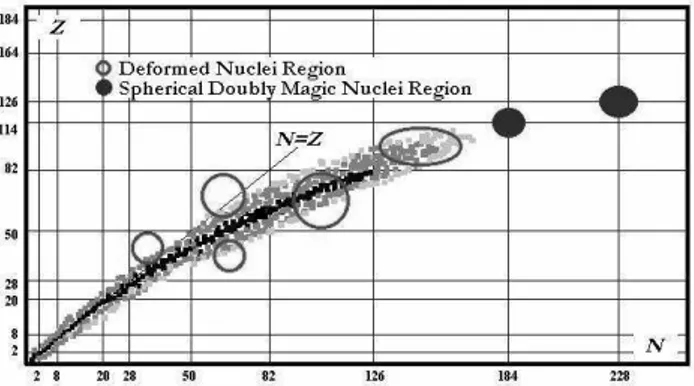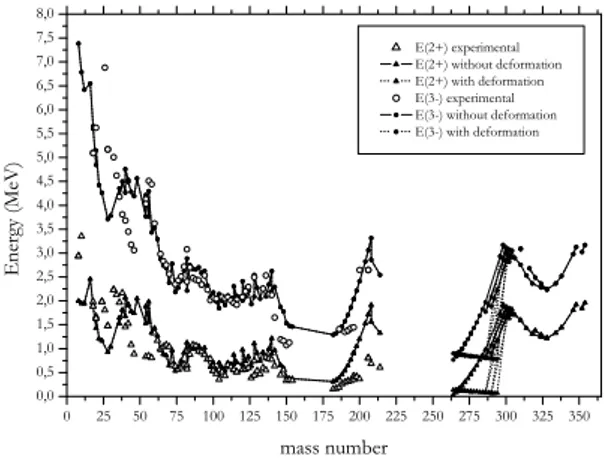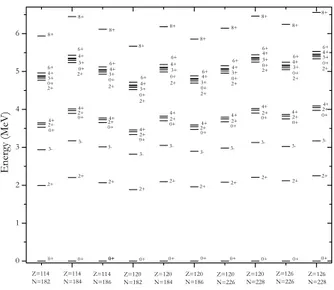Application of Anharmonic Vibrational Models for
Energy Spectrum Studies of Superheavy Nuclei
R. Kuramoto
Instituto de Pesquisas Energ´eticas e Nucleares, IPEN, 05508-900, S˜ao Paulo, SP, Brazil
and C. R. Appoloni
Universidade Estadual de Londrina, UEL, C.P. 6001, 86051-970, Londrina, PR, Brazil
Received on 10 July, 2003. Revised version received on 3 November, 2003
The recent resumption of the synthesis of new superheavy nuclei has provided relevant results for nuclear physics and chemistry. These nuclei provide experimental confirmation of theoretical calculations that predict the existence of two islands of stability, one with maximum stability in Z=114 and N=184 and the other in Z=120 or Z=126 and N=184 or N=228. Through cold fusion, recently synthesized nuclei with Z=114, 116 and 118 have confirmed the theoretical predictions, providing a possibility of reaching the maximum of these islands of stability. Because of the low production rate and the extremely short half-life of these nuclei, it has not yet been possible to determine their energy spectra. However, it has been theoretically predicted that the nuclei should acquire a spherical form in these islands of stability, thus supplying characteristic vibrational energy spectra. The predictions also indicate the existence of deformed superheavy nuclei in the region between the islands, which can possess rotational energy spectra. In this work, the hydrodynamic equation of energy was corrected by inserting terms referring to coulombian effects, shell closure and nuclear deformation, enabling us to predict the energies of the first excited state for superheavy nuclei of quadrupole deformation, the quadrupole phonon state and an octupole phonon for spherical superheavy nuclei. Four anharmonic vibrational models were then used to describe higher energy states of the nuclei in question. The energy spectra of the266104,268106, 270108
,274110 ,278112
,298114 ,304120
,348120 ,354126
nuclei and their closest neighbors were determined.
1
Introduction
Theoretical predictions reconciled to recent experimental in-dications of the existence of islands of stability for super-heavy elements (SHEs) have been testing to the limit the concepts about nuclear structures and heavy ions.
Experiments conducted in Dubna[1] through nuclei re-actions of evaporation channels of 4 and 5 neutrons have indicated a deformed nuclei region of great stability close to the270Hs108.
In the case of doubly magic spherical nuclei, theoreti-cal predictions over the last twenty-five years have indicated that the next island of stability, after the closure of layers of 126 neutrons and 82 protons of208P b
, is around the re-gion of Z=114 and N=184, which forms the element298114 [2-5]. In addition to this island, recent calculations have pre-dicted a second region of stability close to Z=120 or Z=126 with N=184 or N=228, which refers to the304120
,348120 , 310126
and354126
elements [2-5]. Fig. 1 is an extension of Segr`e’s graph for superheavy nuclei, indicating the possible regions where doubly magic spherical nuclei can exist.
The most recent member of the SHEs family was synthe-sized in early 1999 in Berkeley[6, 7] through so-called cold fusion[7, 8], whereby the bombardment of 86Kr ions on
Figure 1. Predictions of islands of stability for superheavy nu-clei. The first island occurs in Z=114 and N=184 and the second in Z=120 or Z=126 and N=184 or N=228. The presence of deformed nuclei is predicted in the regions among these islands.
208P b
doubly magic nuclei produces the compound nucleus with Z=118. In a low excitation state, evaporating only one neutron, the final product obtained is the293118
element and its immediate decay product, the289
116element.
these nuclei can indicate their existence. A recent analysis in Berkeley, made possible by the sufficiently long half-life of the isotope of the transactinide bohrium[9] element, with Z=107 and N=160, indicated that this element is a member of group VII of the periodic table.
Due to the current impossibility of determining these new nuclei properties experimentally, several theoretical models successfully used in the well-known description of nuclei have been extrapolated in order to predict some of their nuclear characteristics. In this work, the application of hydrodynamic collective and anharmonic vibrational mod-els was extrapolated to predict the energy spectra of de-formed and spherical superheavy nuclei.
With the purpose of predicting the energy of the states of an E(2+
) quadrupole phonon and an E(3−
) octupole phonon of superheavy nuclei, three dependences involving the nuclear structure were introduced into the hydrodynamic equation of nuclear excitation energy(HEE)[10]. The first was a dependence on Z involving the coulombian effects in the nucleus in question. The second involved the shell closure effect in doubly magic nuclei[11]. The third depen-dence concerned the deformation of superheavy nuclei[11] among the aforementioned islands of stability. Four an-harmonic vibrational models were used, starting from the E(2+)
andE(3−)
energies, to predict the energy of the su-perior excitation states.
The energy spectra in the deformed superheavy nuclei region should present rotational characteristics. The
rota-tional states of some well known nuclei described by Yrast’s lines are predicted in Casten and Zamfir’s(CZM)[12, 13, 14] model. Through its applicability in the construction of the energy spectrum of some well-known rotational nuclei, the CZM may yield the energy spectra of the266104
,268106 , 270
108,274110,278112nuclei and their closest neighbors. The spectra of spherical superheavy nuclei, whose exis-tence is predicted in the proximities of the aforementioned islands of stability, should display characteristic excitation levels of vibrational modes, which can be predicted by the application of vibrational models of anharmonic terms in the hamiltonian of the nuclear system. The applicabil-ity of the anharmonic vibrational models of Hadermann et al.(HAM)[15, 16], Brink et al.(BRM)[15, 17] and DAS et al.(DAM)[15, 18] was verified by the construction of the energy spectrum of well-known vibrational nuclei[19, 20]. After calculating the E(2+)
and E(3−
) energies, the en-ergy spectra of the298114
,304120 ,348120
, and354126 nu-clei and their neighbors were predicted through successive applications of the three anharmonic vibrational models in question.
2
Hydrodynamic equation of energy
The final form of the HEE forn phonons of multipolarity λ= 2or3with the coulombian, shell and nuclear deforma-tion correcdeforma-tions is given by:
⌋
E(I±) = ǫ5 A
λ(λ−1)
(λ+ 1) [6.25(λ+ 1)(λ+ 2)A−1.5Z
2
] 12
− 0.58s(N, Z)e−α2
αo + 8(M eV) (1)
⌈
The first term of Eq. (1) is obtained through the liq-uid drop model, introducing a total charge Z uniformly dis-tributed over its volume[10]. The analogy between the liq-uid drop model and the collective modes of the nuclear vi-brations has its limitations, since it is the first excited state of nuclear vibration in the order of some hundreds ofkeV, whereas, for a liquid drop, this state reaches some M eV. To find lower energy values, the first term of the HEE was parameterized through a constant multiplierǫcalled the alo-metric parameter. The ǫ parameter was obtained by ad-justing the experimental E(2+)
andE(3−)
data for well-known nuclei, which yielded, respectively, ǫ(2+
) = 0.15
andǫ(3−
) = 0.30.
The correction for shell closure is represented by the functions(N, Z), whose mathematical form is the same as the shell correction term for the semi-empirical mass form described by W.D. Myers and W.J. Swiatecki[11] as:
s(N, Z) =F(N) +F(Z) (1
2A)
2 3
−0.26A31 (2)
whereF(N)andF(Z)have the same dependence onNand onZ, respectively:
F(N) = 3 5
M
5 3
i −M
5 3
i−1 Mi−Mi−1
(N−Mi−1)
− 3
5(N 5 3 −M
5 3
i−1), withMi−1< N < Mi(3) andMicorresponds to the i-th magic number.
The nuclear deformation[11] is described by the expo-nentiale−
α2 αo where:
α2
=β2R 2 o
4π (4)
andβis the nuclear deformation parameter.
Figure 2 illustrates the good agreement between Eq. (1) and theE(2+)
andE(3−)
and corrected HEE. Although nuclear deformation param-eters were not used in this adjustment, the deformed rota-tional nuclei region is very closely approximated by the cor-rected HEE. The extrapolation of the superheavy nuclei re-gion is represented in the same figure. The deformation pa-rameters calculated by J. Meng and N. Takigawa[21] were employed for the Z=104, 106, 108, 110 and 112 nuclei.
Figure 2. Results obtained by the corrected HEE for theE(2+) andE(3−)energies of well-known nuclei.
3
Energy spectrum of deformed
su-perheavy nuclei
Casten and Zamfir’s(CZM) model is given by the energy equation for an anharmonic vibrator:
En(I) =nE1(2+
) +n(n−1)
2 ǫ4 (5)
where the first term corresponds to the harmonic vibrational model expression of annphonons state and the second term corresponds to the anharmonicity introduced. This model, according to the authors[12, 13, 14], correctly predicts the excited states of collective characteristic nuclei, including rotational, vibrational and vibrational-rotational transition nuclei, presenting discrepancies in the order of1%from the I∼28nuclear spin states.
To verify the applicability of CZM to predict the energy spectrum of deformed nuclei, the232T h
,234U
and242P u spectra were built and compared with their respective exper-imental spectra. The results obtained were satisfactory, with greater deviations observed only for spin-parity states above
10+ .
The values of theǫ4 parameter were calculated for ro-tational nuclei in the region of 224 <A< 256, based on their experimental values ofE(2+
)andE(4+
)energies. A function with the form: ǫ4 = c1+c2exp[−(A−c3)/c4]
was used to fit these values in order to determine thec1,c2, c3andc4constants and, by extrapolation, to predict theǫ4 value for superheavy nuclei in the 270Hs108
region. The values obtained were:c1= 0.0576,c2= 0.0315,c3= 224, andc4 = 4.2386. The deformed superheavy nuclei region
in question is located close to A=270, not very far from the last nuclide considered in this calculation. Thus, theǫ4 val-ues predicted by the adjusted equation should not differ sub-stantially in this region, which justifies an extrapolation of this parameter.
TheE(2+
)energy of the nuclei in the270Hs108region was found by extrapolating the corrected HEE, Eq. (1). The ǫ4 values were determined based on the calculations de-scribed in the previous paragraph. Thus, using the CZM, we built the rotational energy spectra of the266104
,268106 , 270
108,274110, and278112deformed nuclei and their clos-est neighbors. These spectra are illustrated in Fig. 3.
Figure 3. Predicted spectra for deformed superheavy nuclei.
4
Energy spectra of spherical
super-heavy nuclei
As mentioned in sec. 1, the first step in the construction of the energy spectrum of a vibrational nucleus is to iden-tify theE(2+)
energy of a quadrupole phonon state, from which, after the successive application of the three anhar-monic vibrational models, HAM, BRM and DAM, one can describe the subsequent excited states. This energy was ob-tained directly from the HEE extrapolation, taking as zero the deformation parameters of the nuclei in question, since they are probably spherical. In order to verify the three mod-els’ applicability, they were used only to describe the energy spectrum of ten nuclei in the60<A<196[19] region. The results obtained showed good agreement with the respec-tive experimental spectra, confirming the applicability of the three anharmonic vibrational models.
Starting from theE(2+)energies of the supposed spher-ical superheavy nuclei obtained through the corrected HEE extrapolation, the HAM gives the energies of the0+
,2+ and
4+
states of two-quadrupole phonon triplet of these nuclei. Based on the values of these energies, the BRM provides the states of the three-quadrupole phonon quintuplet. Through theE(2+)
andE(4+)
energies, the DAM provides the6+ quintuplet state, in agreement with the BRM and hence, through this same model, one can predict the8+
the four quadrupole phonon state. The3−
energy state of an octupole phonon for superheavy nuclei is obtained directly from the corrected HEE extrapolation. Hence, the energy spectrum of the aforementioned supposed spherical super-heavy nuclei can be built based only on knowledge of the E(2+
)andE(3−
)energies.
Studies on the110Cd,112Cd,114Cdand110P d vibra-tional nuclei by J. Kern and J. Jolie J.[22] have shown that theE(2+)
energy should be renormalized, that is, increased by15%, so that the BRM and the DAM can supply lower states of energies coherent with the experimental spectrum of the nuclei in question. Thus, after the energies of the two-quadrupole phonon triplet for the spherical superheavy nuclei were calculated, theE(2+)
energy was renormalized and BRM and DAM then applied to predict the three and four quadrupole phonon states.
The energy spectra predicted for298114 ,304120
,348120 , and354
126doubly magic superheavy nuclei and their neigh-bors are illustrated in Fig. 4.
Figure 4. Energy spectra predicted for spherical superheavy nuclei.
5
Gamma transitions in superheavy
nuclei
The amount of gamma ray energy emitted in the de-excitation process of superheavy nuclei after their formation can be measured today. Thus, theE2transitions, which are the most probable, were calculated for the superheavy nu-clei, whose spectra were predicted. In the calculations for spherical superheavy nuclei, the quadrupole phonon state was not renormalized. Table I lists the results for the de-formed nuclei while Table II lists the results for the spherical nuclei.
TABLE I. Prediction for theE2transitions in deformed su-perheavy nuclei.
nucleusAZ E2(2+ →0+
) E2(4+ →2+
)
264104
0.1387 0.2661
266104
0.1405 0.2679
268104
0.1423 0.2696
266106
0.1281 0.2554
268106
0.1302 0.2575
270106
0.1322 0.2595
268108
0.1166 0.2440
270108
0.1190 0.2464
272
108 0.1213 0.2487
272
110 0.1068 0.2341
274
110 0.1095 0.2368
276110
0.1120 0.2394
276112
0.0963 0.2237
278112
0.0994 0.2267
280112
0.1022 0.2296
average 0.1197 0.2470
TABLE II. Prediction for theE2transitions in spherical su-perheavy nuclei.
nucleusAZ E2(2+ →0+
) E2(4+ →2+
)
296114
1.7342 1.9142
298114
1.9171 2.0971
300114
1.7973 1.9773
302120
1.6387 1.8187
304120
1.8213 2.0013
306120
1.7051 1.8851
346120
1.8077 1.9877
348
120 1.9217 2.1017
352
126 1.8440 2.0240
354
126 1.9573 2.1373
average 1.8144 1.9944
As can be seen in Table I, the average value of theE2
transitions, from the2+
state to the fundamental state of the deformed superheavy nuclei, is0.1197M eV. For the spher-ical superheavy nuclei, the average value of this transition is1.8144M eV, as indicated in Table II. ForE2transitions from the4+
state to the2+
6
Conclusion
As can be observed in Fig. 2, the HEE[10], corrected by the insertion of the coulombian, shell and deformation de-pendences, offers an excellent description of the experimen-tal data of theE(2+)
andE(3−)
excitation energies. This good agreement with experimental data in such a wide band of measurements makes it possible to extrapolate the HEE for superheavy nuclei.
The applicability of CZM[12, 13, 14] in the construc-tion of the energy spectrum of rotaconstruc-tional nuclei was verified through the prediction of the energy spectra of some well-known rotational nuclei and through Yrast’s line study of ro-tational, vibrational and rotational-vibrational transition nu-clei. As for the extrapolation of the ǫ4 parameter for the deformed superheavy nuclei region, it appears acceptable because of its very well-defined functional variation, which supplies a substantially constant value for theǫ4parameter due to the adjusted exponential saturation. Thus, the pre-dicted energy spectra are acceptable for the266
104,268
106, 270108
,274110
, and278112
nuclei and their closest neigh-bors.
In the case of the prediction of energy spectra for supposed spherical superheavy nuclei, the applicability of HAM[15, 16], BRM[15, 17] and DAM[15, 18] was veri-fied by the construction of the energy spectrum of ten well-known vibrational nuclei. These three models were applied sequentially, starting from theE(2+)
energy value supplied by the HEE extrapolation, to predict the energy spectra of 298114
, 304120
, 348120
, and 354126
spherical superheavy nuclei and their neighbors. TheE(2+)
was renormalized, as proposed by J.KERN and J.JOLIE[22], allowing the BRM to provide lower states of energy and, consequently, more coherent results, as verified for some well-known nuclei.
The predictions obtained by CZM, HAM, BRM and DAM for well-known nuclei and the coulombian, shell and nuclear deformation correction terms inserted in HEE pro-vided a solid theoretical base. This allowed for the extrap-olation performed with the HEE, as well as the application of the aforementioned models, to describe the spectra of en-ergies of the superheavy nuclei under study. However, con-firmation of these predictions will only be possible through direct confrontation with experimental data, which are still inexistent today due to the low production rate, high excita-tion energy and extremely short half-life of these nuclei.
A form of verifying such predictions would be by di-rectly measuring the gamma ray energy of these nuclei’s E2transitions. As discussed in sec. 5, due to the consid-erable differences in the values of predicted energy of
de-formed and spherical nuclei, these transitions can also pro-vide important informations on the nuclear deformation of superheavy nuclei. Thus, it is expected that the energy lev-els obtained from the rotational spectra of deformed super-heavy nuclei, and the order and average energy value of the nphonon multiplets predicted for spherical superheavy nu-clei will be coherent with future experimental data.
References
[1] Y.A. Lazarev et al., Phys. Rev. Lett.73, 624 (1994).
[2] K. Rutz et al., Phys. Rev. C56, 238 (1997).
[3] S. Hofmann, Nucl. Phys. A654, 252c (1999).
[4] J. Dudek, Acta Physica Polonica B9, 919 (1978).
[5] H. Meldner, Arkiv f¨or Fysik36, 593 (1966).
[6] CERN Courier, Superheavy Elements, september (1999) 18.
[7] V. Ninov et al., Phys. Rev. Lett.83, 1104 (1999).
[8] Y.T. Oganessian et al., Nucl. Phys. A239, 353 (1975).
[9] CERN Courier, Bohrium Finds a Place in the Table, february (2000) 9.
[10] J.M. Irvine, Nuclear Structure Theory, Pergamon Press (1972) 219.
[11] W.D. Myers, W.J. Swiatecki, Nucl. Phys.81, 1 (1966).
[12] R.F. Casten, N.V. Zamfir, D.S. Brenner, Phys. Rev. Lett.71, 227 (1993).
[13] N.V. Zamfir, R.F. Castem, Phys. Lett. B341, 1 (1994).
[14] N.V. Zamfir, R.F. Castem, Phys. Rev. Lett.75, 1280 (1995).
[15] C.R. Appoloni, An´alise de canais acoplados da reac¸˜ao 142
Ce(a, a′)142
Ce∗: Estudo de um n´ucleo de transic¸˜ao
vibracional-rotacional, Doctoral Thesis, Universidade de S˜ao Paulo, Instituto de F´ısica (1983) 66.
[16] J. Hadermann, A.C. Rester, Nucl. Phys. A231, 120 (1974).
[17] D.M. Brink, A.F.R. de Toledo Piza, A.K. Kerman, Phys. Lett.
19, 413 (1965).
[18] T.K. Das et al., Phys. Rev. C2, 632 (1970).
[19] R.Y.R. Kuramoto, Aplicac¸˜ao de modelos vibracionais an-armˆonicos para o estudo do espectro de energia de n´ucleos superpesados, Report, Universidade Estadual de Londrina (2000)
[20] E. Browne, J.M. Dairiki, R.E. Doebler,Table of Isotopes. 1st Ed. John Wiley & Sons (1978).
[21] J. Meng, N. Takigawa, Phys. Rev. C6106, 4319 (2000).


